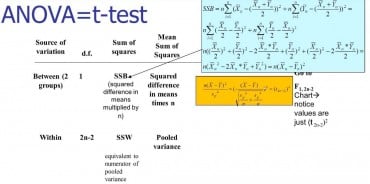DEFINITION of ANOVA
ANOVA is the partitioning of the total sum of squares into the sum of squares explained by the model and the remaining sum of squares which is not possible to explain.
Complicated definition indeed. But this is a very important analysis.
WHAT IT IS IN ESSENCE
ANOVA tests the hypothesis that the means of two or more various groups are equal.
ANOVAs assess the importance of one or more factors by comparing the response variable means at the different factor levels.
The null hypothesis states that all means are equal. While the alternative hypothesis states that at least one is different.
Let’s see.
Speaking about this test, each location is a level of an independent variable, which is really categorical. The dependent variable, however, must be ratio or interval. Because ANOVA’s design allows comparing the means of the theoretical continuous distributions for all of those locations.
Richard Fisher, a British mathematician, was the first who introduced Analysis of variances (ANOVA) as statistical models.
It was in the early 20th century. He was the first who introduced the term variance too.
HOW TO USE
You can use ANOVA in finance in several different ways. It includes forecast the movements of security prices. By first determining which factors influence stock fluctuations.
This analysis can provide valuable insight into the behavior of a security or market index under various conditions.
This statistical model is introduced in the scientific paper. Richard Fisher, the British mathematician wrote this. He is the author of first introducing the term variance.
Fisher also was the father of modern statistics and experimental design. He, therefore, could say that provided researches in biology and medicine. And, he was an architect of the “modern synthesis” that used mathematical models. To integrate Mendelian genetics with Darwin’s selection theories.
Fisher was the single most important figure in 20th-century statistics.
But also, he was supporters of eugenics.

